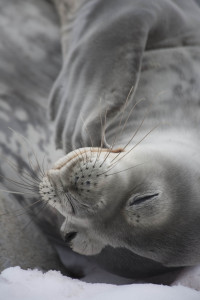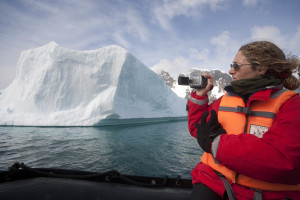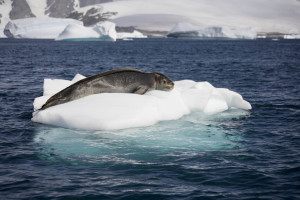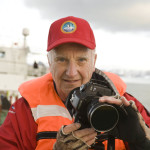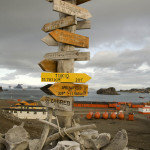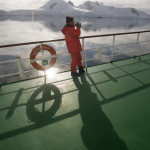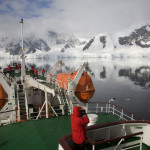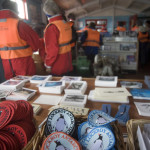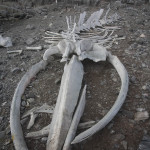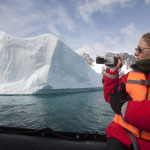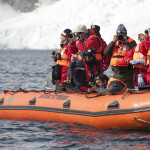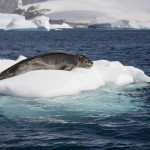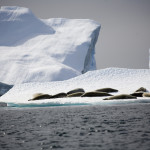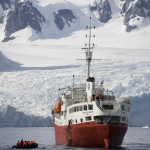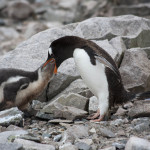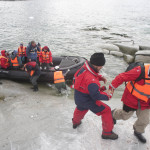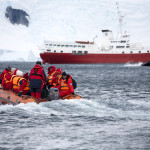Story and photography by Dave Bartruff
As I ventured out on deck of my expedition ship at the start of another exciting day at sea, I was nearly blinded by the brilliant blanket of snow that coated its deck from the tip of its bow to the helicopter pad at its stern. What a surprise: this was the middle of summer! Summer in Antarctica!
Though the opportunity to throw a snowball or two was tempting, I knew there was plenty of adventure ahead on shore, and I didn’t want to miss any of it.
I could tell by the sound of the engines, we had reached our offshore anchorage. The anchor was about to go down, as well as the four rubber Zodiacs stored on the platform aft. These swift 16-foot-long landing craft carry 10-12 adventurers. Their 60 horsepower outboard motors speed you to shore where you finally set foot on the fabled White Continent for the first time, and your Antarctic dream becomes reality!
I was aboard the Antarctic Dream, a small 2,180-ton polar iceboat with a reinforced hull built for adventure. Featuring just 39 cabins, (four of which are suites) for 78 passengers, the ship had an elite, mostly Chilean crew of 36 commanded by the legendary Swedish captain, Peter Skog. His long career at sea spans more than four decades. The congenial Swede has been navigating in Antarctic waters on more than 100 voyages since 1974, longer than any other ship master currently sailing here. Skog is also a master linguist, fluent in English, Spanish, German and Swedish.
Today’s first landing was at Port Lockroy, a place with a checkered past: beginning as a whaling station from the late 1800s to the 1930s. During World War II, the site became Great Britain’s secret “Base A” for monitoring German shipping movements. Abandoned after the war, the original station building has now been restored and turned into an historical museum and gift shop, with its wartime decor and trappings of the 1940s still authentically preserved.
It also affords adventurers the unique opportunity to have their passports hand stamped to authenticate their Antarctic visit. Talk about a conversation piece when you go through passport control on your arrival home or when sharing your unique travel experience with friends and neighbors. Incidentally, Antarctica belongs to no nation, but has various national scientific stations on its soil according to international treaty agreements.
In the short November through February Antarctic tourist season, (which is summer in the Southern Hemisphere), nearly 10,000 adventurers venture here. Only 350 each day are allowed to land at Lockroy, just 60 at a time so not to endanger the fragile environment.
From Lockroy, another short Zodiac ride lands you amidst a vast Gentoo penguin rookery at Jougla Point. Some 800 pairs of adult Gentoo and their chicks nest here. You’re virtually up to your knees in the little creatures when you step on shore. By moving quietly among the inhabitants, you pose no threat to them as they go about their nesting, and grooming activities.
Indeed, by just sitting down on an available rock for 5-10 minutes you become an object of their curiosity; and the penguins may actually come to you. So it was with fellow shipmate, Johanna Chang, an elementary school teacher from Taichung, Taiwan. It was fascinating to watch as a curious (or hungry) young Gentoo used its little beak to probe Johanna’s every parka pocket and fanny pack zipper as she sat serenely by. An adorable little “pick pocket!”
On the shoreline of the rookery, I found a myriad of century-old whalebones now colored green by algae. Nearby, a completely reconstructed whale skeleton lay on the ground. It must have measured a good 20 yards in length.
But my closest, and most rewarding encounter with Antarctica’s wildlife was just around the corner. It was nearly time to board the last Zodiac back to the ship, when an out-of-breath fellow passenger told me of his great discovery in the neighboring cove. In a flash, I clambered as best I could along the rocky shoreline towards the prize.
At last I reached it: there stretched out on a patch of soft snow, was a sleepy nine-foot-long Weddell Seal. I approached him cautiously, but he was sound asleep. I got so close, I could have tickled his whiskers! I didn’t though. There was just enough time to shoot some real close, close ups before racing back to the waiting Zodiac.
Several days earlier, we had made our first landing on the Antarctic Continent at Neko Harbor, at the head of a massive glacier and our first opportunity to meet and march amongst the penguins.
Five of the ten days on the Antarctic Dream’s expedition cruises are devoted to “boots on the ground” landings on the Antarctic Continent and its offshore islands via Zodiacs. Weather and safety play a big role in these landings. Up to three shore landings per day are scheduled during the long summer days. (One day the sun rose at 4:27 am set at 10:16 pm.) Altogether, we safely accomplished a total of eight landings without incident. Actually our whole first excursion day was lost due to high winds that prevented Zodiac movement. Instead, we went on whale chases rewarding us with many sightings and wonderful photo “Ops.”
What most amazed we first-time Antarctica adventurers were its intrepid penguins. “Imagine,” our expedition leader explained: “hatching out of an egg in mid-November and growing into a self-sufficient adult by March, when you then take off on your own to face the cruelest weather on the planet. Talk about real guts!”
The nearly 1,200 mile sailing aboard the Antarctic Dream included many other once-in-a-lifetime experiences like a zodiac excursion off Pleneau Island piloted through blue ice flows as tall as five and ten-story buildings. One floating marvel looked like a Greek temple with sculpted Corinthian columns, another like a transparent Oriental dragon. On flat snow flows that resembled floating tanning salons, we encountered up to a dozen seals at a time basking together in the brilliant Antarctic sunshine.
Another memorable moment was our entry into Deception Island, a spectacular caldera, remnant of a collapsed active volcano that last erupted in 1970. We sailed in through the caldera’s only entrance called, “Neptune’s Bellows,” a tricky, narrow passage, but one often negotiated by our own Captain Skog. Just a week earlier, however, a larger expedition vessel with 300 passengers aboard ran aground in these narrows. All aboard had to abandon ship and wait on shore for rescue. The incident attracted worldwide media coverage.
Once ashore by Zodiac ourselves inside the caldera, we hiked up to the top of its 1,500-foot-high outer rim for a panoramic view of the whole two-mile-wide volcanic remnant. Before our departure, we made a second Zodiac landing where a number of our group (male and female) stripped down to their bathing suits and dug themselves into the warm volcanic sands and waters that came to the surface. Then the heartiest of the hearty, including even women, finished off their Antarctic spa experience by dashing headfirst into the caldera’s icy waters to “cool down!”
By day’s end, our final shore landing took place in Maxwell Bay on King George Island, one of the South Shetland Islands. There at anchor lay the empty vessel disabled at Deception Island. On shore we visited both the Chilean and Russian scientific bases that are among eight nations located here year round.
Our return voyage ended in spectacular fashion as we approached Ushuaia, Argentina, the southernmost city in the world, where our voyage had begun just 11 days earlier. As we nudged into port in a light rain shower, suddenly the sun broke through and a rainbow covered the whole harbor with its brilliant halo. Truly we’d found our “pot of gold”… on board the Antarctic Dream, where dreams really do come true.
- Expedition photographer Dave Bartruff
- Expedition members soak in volcanic thermal sands
- Global destination markers atop whale-bone base
- Near “midnight sun” draws a photographer on deck
- Gliding through a photographer’s paradise
- ntarctic souvenirs at 1800s whaling station
- Relic century-old whale bones ashore
- Dramatic snow-covered shoreline miniaturizes ship
- Woman in Zodiac films summer ice-flows
- Zodiac full of photographers crouched and standing
- Closeup of seal napping on tiny ice-flow
- Seal colony asleep on ice-flow
- Zodiac returns to ship with dramatic snowy backdrop
- Photographing from Zodiac amid ice flows
- Nesting penguin asleep atop gravel nest
- Penguin mother feeding oversize youngster
- Expedition group landing ashore from Zodiac
- Extreme weather-proofed female expedition member
- Expedition group in zodiac return to ship

